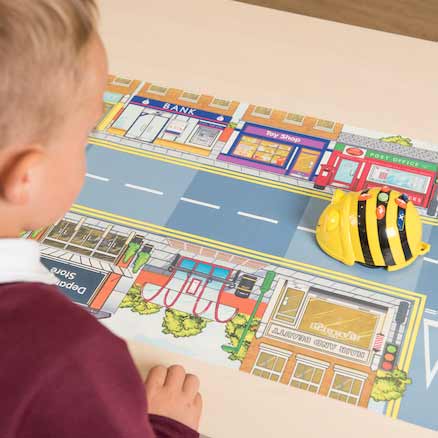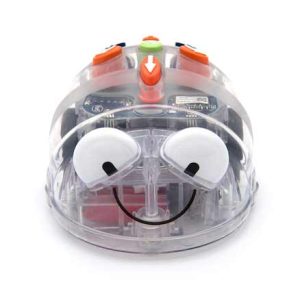Welcome to the world of hands-on learning with TTS Bee-Bot® and Blue-Bot® programmable floor robots! Designed to captivate the imaginations of young learners, these robots are perfect for sparking curiosity and fostering critical thinking in UK schools. Whether you’re looking to enhance your existing STEM club or kickstart a new initiative, Bee-Bot® and Blue-Bot® offer an engaging, curriculum-aligned solution that brings programming to life for students aged 3 and up.

With a focus on creativity, collaboration, and problem-solving, these robots provide an excellent platform for students to explore fundamental programming concepts in a fun and interactive way. In this article, we’ll dive into how you can effectively integrate Bee-Bot® and Blue-Bot® into your school’s curriculum and activities, ensuring a rich and rewarding learning experience for all.
Why Choose TTS Bee-Bot® and Blue-Bot®?
1. Curriculum-Aligned Learning
Bee-Bot® and Blue-Bot® are designed to support the UK National Curriculum, particularly in Key Stages 1 and 2. These robots help students develop essential skills such as:
- Creating and Debugging Simple Programs: Students can learn to write and troubleshoot basic sequences of commands.
- Logical Reasoning: Encouraging students to think step-by-step and predict outcomes.
- Understanding Algorithms: Exploring how algorithms translate into executable programs on digital devices.
2. Engaging and Interactive
Both Bee-Bot® and Blue-Bot® feature intuitive interfaces that make programming accessible for young learners. Students can control the robots using arrow keys or Bluetooth-enabled devices, allowing them to create mazes, solve puzzles, and even design their own games.
3. Robust and Durable
Built to withstand frequent use, Bee-Bot® and Blue-Bot® are designed with durability in mind. Each robot can handle over 500 recharges, ensuring longevity and reliability. Their transparent shells also allow students to see the internal components, fostering a deeper understanding of how technology works.
| STEM Club Ideas for Primary Children | |
|---|---|
| Activity Type | Description |
| Science Experiments | Perform simple experiments both indoors and outdoors, such as Popping Rockets, Erupting Volcanoes, and Mentos Geysers. |
| Minibeast Hunts | Go on minibeast hunts, pond dipping, and use magnifying equipment to observe plants, insects, rocks, and fossils. |
| Climate Change Exploration | Explore ways to combat climate change by making simple solar panels and wind turbines, or investigating the school’s carbon footprint. |
| Yearly Science Fair | Organize a yearly school science fair for children to showcase their science experiments and findings, helping to develop self-confidence and presentation skills. |
| Robot Programming | Use Bee-Bot and Blue-Bot to program robots to move along themed mats, set up treasure hunts, play games, and create obstacle courses. |
| Building Computer Games | Use Scratch and popular apps like CodeSpark and Hopscotch to build simple computer games, letting children create their own characters, backgrounds, and challenges. |
| Basic Animation | Teach basic animation techniques using tablets and free apps like Stop Motion or iMotion. Children can create short stop-motion animations with animals and characters. |
| Dance and Music Sequences | Use coding apps to create dance routines and music sequences, allowing children to debug and adapt their creations based on audience feedback. |
| Website Building | Teach children HTML/CSS to build websites. Set challenges for them to create websites for different purposes, such as showcasing their favorite hobbies. |
| Building Structures | Encourage children to build structures and test their strength using construction kits like LEGO, K’NEX, and Polydron. |
| Vehicle Design | Design and build vehicles, organizing races to see which vehicle travels the farthest or performs best. |
| Hydraulic Systems | Design and make hydraulic systems to create moving parts, encouraging problem-solving and creativity. |
| Junk Modelling | Have junk modelling sessions where children use recycled materials to create models and solve design challenges. |
| Times Tables | Use snap cubes and other manipulatives to explore times tables in a hands-on way. |
| Fraction Exploration | Use foam fraction pieces to understand fractions in a fun and interactive way. |
| Counting Games | Play counting games using giant floor number tiles and other interactive tools. |
| Math Competitions | Hold math competitions and challenges to encourage children to explore areas of interest in more depth. |
| Scavenger Hunts | Organize scavenger hunts that involve solving math puzzles and riddles. |
| Stop-Motion Animation | Create stop-motion animations using tablets and free apps like Stop Motion or iMotion. Children can use model figures and buildings to create short films. |
| Artistic Creations | Encourage children to use Bee-Bot pen holders to create intricate designs and patterns. |
| Music and Dance | Use coding apps to create dance routines and music sequences, allowing children to debug and adapt their creations based on audience feedback. |
| Visual Art Projects | Engage children in visual art projects, such as painting, drawing, and sculpting, to foster creativity and self-expression. |
| Theater and Drama | Organize theater and drama activities, encouraging children to act out stories and develop their performance skills. |
4. Comprehensive Classroom Pack
The TTS Bee-Bot® and Blue-Bot® Programmable Robot Classroom Pack includes everything you need to get started:
- 5 x Bee-Bot® Robots
- 1 x Blue-Bot® Robot
- 1 x Charging Docking Station
This pack is ideal for group activities and ensures that every student gets hands-on experience with programmable robots.
Recommended products
-
Programmable Floor Robot Bee-Bot
£58.99 -
Blue-Bot® Bluetooth Programmable Robots
Original price was: £102.99.£59.99Current price is: £59.99.
How to Get Started with Bee-Bot® and Blue-Bot®
1. Initial Setup
Before diving into activities, ensure your robots are ready to go:
- Charging: Connect the robots to the docking station and let them charge fully.
- Software: Download the free TTS Bee-Bot® and Blue-Bot® apps for iOS and Android devices. These apps enhance the learning experience by allowing wireless control and interaction.
- Testing: Conduct a brief test run to verify that all controls are functioning correctly.
2. Basic Operations
Once setup is complete, students can begin exploring the basic operations of Bee-Bot® and Blue-Bot®:
- Navigation: Use the arrow keys to move the robot forward, backward, left, and right.
- Sequencing: Input a series of commands to create a sequence of movements.
- Loops and Conditional Statements: Introduce more advanced programming concepts by incorporating loops and conditional statements into your sequences.
| TTS Bee-Bot® and Blue-Bot® Programmable Robot Classroom Pack | |
|---|---|
| Feature | Description |
| Classroom Pack Contents |
|
| Curriculum Alignment |
Aligned with the UK National Curriculum for:
|
| Ease of Use |
Bee-Bot® and Blue-Bot® feature simple, intuitive interfaces:
|
| Durability |
Built to withstand frequent use:
|
| Educational Software |
Comes with a free-to-download app, enhancing the interactive learning experience:
|
| Additional Resources |
Download free teaching materials to enhance your STEM club: |
| Price and Savings |
Save up to £130* with our promotional offers:
*Terms and conditions apply. |
3. Curriculum Integration
Bee-Bot® and Blue-Bot® can be seamlessly integrated into your school’s curriculum. Here are some ideas for incorporating these robots into your lessons:
- Science: Use Bee-Bot® and Blue-Bot® to explore simple machines, circuits, and environmental interactions.
- Coding: Teach students how to program the robots using block-based coding, introducing concepts like loops, conditionals, and debugging.
- Mathematics: Create counting games, pattern recognition activities, and problem-solving challenges using Bee-Bot® mats and accessories.
- Art: Encourage creativity by using Bee-Bot® pen holders to draw shapes and patterns, or by designing themed mats for the robots to navigate.
Fun and Engaging Activities
1. Treasure Hunts
Set up treasure hunts around the classroom or playground. Students can program the robots to follow a series of clues, leading them to hidden treasures.
2. Maze Solving
Design mazes using mats and obstacles. Challenge students to program the robots to navigate through the maze, reinforcing spatial awareness and problem-solving skills.
3. Obstacle Courses
Create obstacle courses with varying terrains. Students can program the robots to overcome obstacles, teaching them about precision and adaptability.
4. Storytelling
Develop stories where the robots play key roles. Students can create scenarios and scripts, fostering creativity and narrative skills.
5. Interactive Games
Design and play interactive games that incorporate the robots, promoting teamwork and collaboration. Examples include “Snakes and Ladders,” “Role-Playing Adventures,” and “Dance Routines.”
Real-World Applications
Beyond the classroom, Bee-Bot® and Blue-Bot® have numerous real-world applications:
- Event Demonstrations: Showcase the capabilities of programmable floor robots at school fairs, exhibitions, and workshops to engage audiences and promote interest in technology.
- Corporate Training: Utilize these robots in corporate training programs to teach employees programming and problem-solving skills in a fun and interactive manner.
- Community Outreach: Organize community events and workshops featuring programmable floor robots to promote STEM education and inspire the next generation of innovators.
Customer Reviews and Testimonials
Don’t just take our word for it—here’s what some satisfied customers have to say:
“Children were very excited to use the Bee Bots. They are an excellent IT resource.” — Jo, Verified Buyer
“The rep I spoke to was knowledgeable and informed. Good service.” — Irene, Verified Buyer
“The robots are durable and easy to use. Perfect for our STEM club!” — Sara, Verified Buyer
Download Free Teaching Materials
To help you get the most out of your TTS Bee-Bot® and Blue-Bot® Programmable Robot Classroom Pack, we’ve provided a range of free teaching materials:
- Bee-Bot Accessories Guide
- Bee-Bot App Guide
- Bee-Bot Cross-Curricular Activity Ideas
- Bee-Bot Pupil Challenge Cards
- Bee-Bot Teacher Challenge Cards
- Bee-Bot FAQs
- Bee-Bot Testimonial
- Bee-Bot User Guide
Conclusion
Programmable floor robots like Bee-Bot® and Blue-Bot® offer a unique and engaging way to introduce students to the world of programming and robotics. By fostering critical thinking, enhancing spatial awareness, and promoting teamwork, these robots provide valuable learning experiences that extend far beyond traditional educational settings. Whether used in classrooms, corporate environments, or community events, Bee-Bot® and Blue-Bot® are versatile tools that inspire creativity and innovation.
Embrace the possibilities and embark on a journey of discovery with programmable floor robots today! Visit our website to explore more about Bee-Bot® and Blue-Bot® and discover how they can enhance your school’s STEM club.
Recommended products
-
Programmable Floor Robot Bee-Bot
£58.99 -
Blue-Bot® Bluetooth Programmable Robots
Original price was: £102.99.£59.99Current price is: £59.99.


